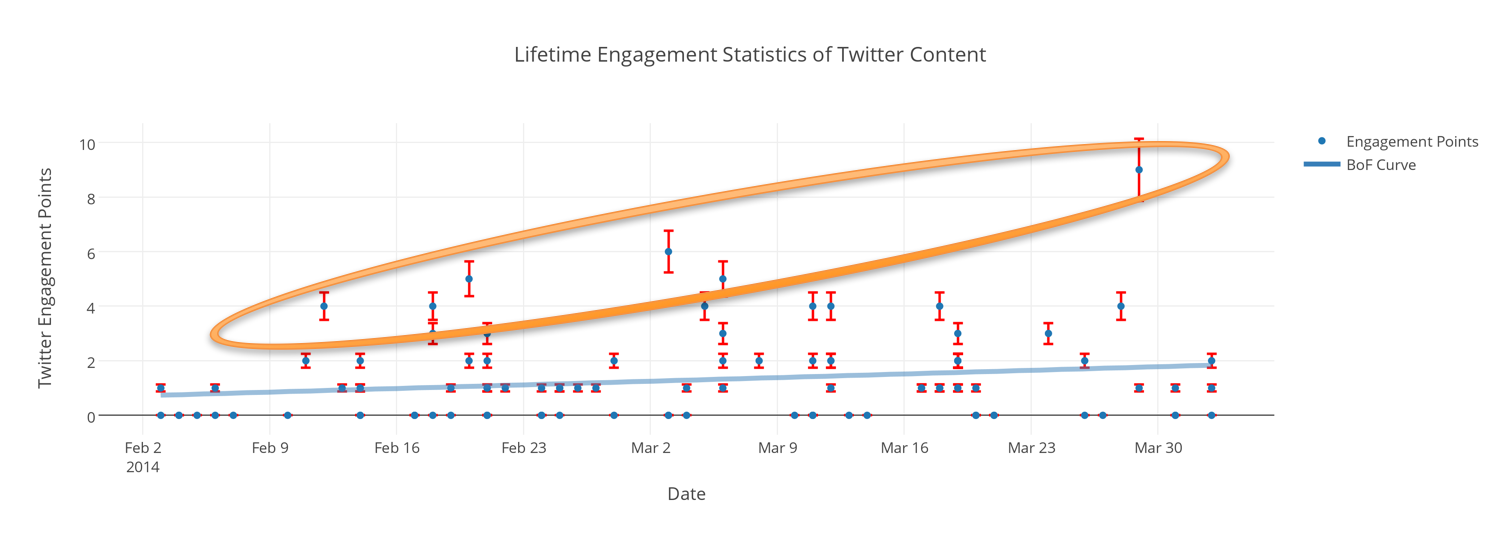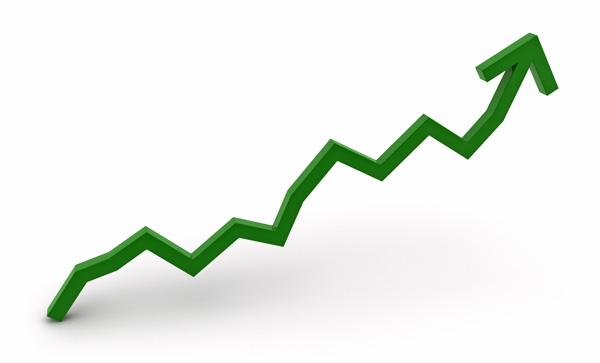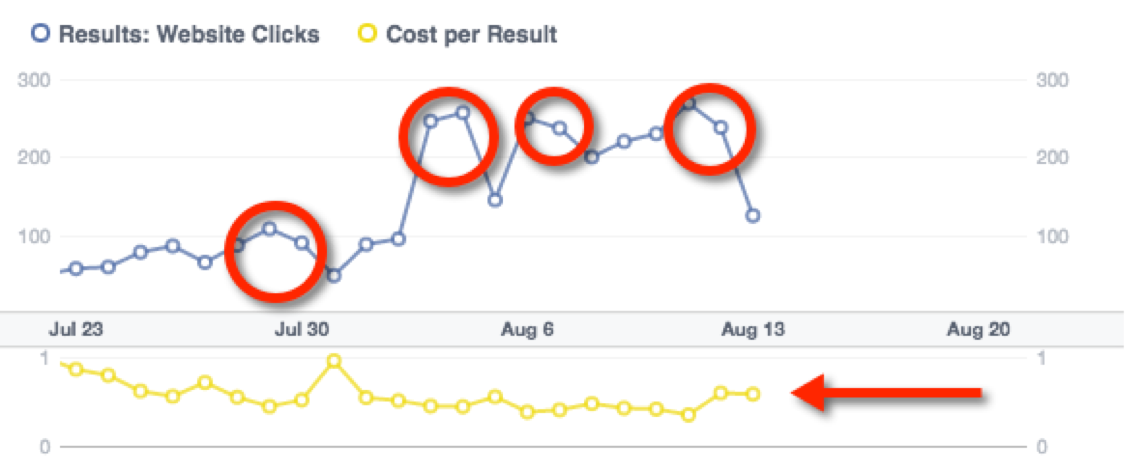Your social data is among the most malleable marketing assets you’ll ever use. It can provide the foundation for virtually any strategy and assist you in the ongoing optimization of any program. It can be the guiding light that consistently helps you build your audience and brand. That’s giving data an awful lot of credit.
So what exactly should marketers be paying attention to when it comes to these stats in order to start taking advantage of them in more valuable ways?
Let me preface this list of metrics by pointing out the fact that when I say data is malleable, I’m not kidding. Marketers need to realize that the elements listed here are only a few of the amazing ways that data can provide insights. With that in mind, let’s take a look at some of these key data metrics.
Outliers
Perhaps the most valuable indicator of importance are outliers within your data sets. When extracting raw data from one of your multiple data sources (e.g. web data, CRM data, social channels or tools, etc.) running a simple linear regression and analyzing your data for outliers (generally within a 5-10% margin of error) will give you excellent insights into where you are seeing certain successes and what efforts might be coming up short.

In regard to what kinds of data sets you should be monitoring for outliers, that depends entirely on what it is you are trying to understand. You might be monitoring for outliers in your engagement statistics (of course, be sure to have a clear definition of what engagement is first), conversions, clicks, or audience data. Virtually any isolated data set can undergo this hugely useful analysis.
Audience Clusters
One of the most exciting aspects of social media (and, in this case, social data) is the level of detail provided by your audience members. Unlike surveys, questionnaires, or even censuses, when it comes to audience profiles on social media, you’re being given answers to questions about your audience that you didn’t even know you had. When you scale that up (with audiences in the hundreds of thousands or millions) it means the ability to create small audience clusters that fall into certain, hyper-targeted pools.
When you identify a high-performing campaign or piece of content, an analysis of the idiosyncrasies of the engaged audience is key. This data will help provide a basis for things like content strategies and editorial calendars, as well as simply help you run more efficient marketing strategies. Look at the converting audience and determine where there are correlations that can help you better position your brand and better invest your resources for the highest possible return.
Correlations
Whether you’re analyzing audience data or post-level data from one of your active social networks, you’ll want to be sure that you’re paying close attention to correlations, both positive and negative. While you don’t necessarily need to dive as deep as running a Pearson product-moment correlation test (and, frankly, it might not be possible depending on the extent of your exported data sets) it certainly helps if you can.
When it’s not possible, you’ll simply want to pay very close attention to similarities as they arise in a particular cluster. For example, analyze high-performing posts in terms of shares on Facebook and note if there are similarities (e.g. time they were posted, a trend of a certain color, post length, etc.) that appear in the majority of these selected items?
Industry Trends
I’ll be the first to tell any marketer about the benefits of using a data gathering and industry monitoring tool like Radian6, Brandwatch, Crimson Hexagon, etc. Data-gathering tools provide marketers with the ability to catch onto up-and-coming trends within your industry (before your competition) and react.

Keep a close eye on upward-trending conversations and conversation topics around your industry, brand, and competitors. The insights garnered from this practice can help you in a number of impactful ways, some of which include providing you with inspiration for your next campaign, or highlighting missteps taken by your competitors that you might want to avoid.
Competitive Intelligence
On a similar note, data-gathering tools like those listed above are ideally suited for aggregating data about your competitors. Moreover, there exists a whole subset of these products specifically designed for tracking competitive data, such as Compete, Zuum, and Rival IQ. The insights that these products bring to light are crucial when trying to stand out in a crowd.
In regard to what you should be tracking when it comes to your competitors, pay close attention to the proverbial negative space. Analyzing campaigns and a brand’s presence is one thing, but there is a tremendous opportunity where a competitor is not yet present. Keep an eye on the average share of voice of competitors in your industry monitoring practices, and note when the conversation around one or several competitors takes a dip (or doesn’t exist at all). That is where you’ll have the lowest barriers to entry and a much easier time capitalizing on the untapped market.
Budget Optimization
Saving one of the most important points for last, your data offers you immediate insights on how you can get more out of your advertising budgets. There are a lot of tools that provide an automated form of budget optimization, but sometimes a manual touch is needed.
When advertising on Facebook, Twitter, or LinkedIn, your goal is to acquire new customers or drive engagement at a minimal cost to yourself. For these networks, the goal is to both drive results and exhaust your budget as quickly as possible in order to influence further investment. Manual bidding strategies should pay attention to cost-per-click bid and average click-through rate and slowly adjust accordingly in order to extract every bit of potential that comes with each bid. The end result will look a little something like this:

Looking at the screenshot above, where this approach to budget optimization has taken place, cost-per-click averages have been leveled, while the total click volume and click-through rate have managed to increase over time—as opposed to the more likely (and common) trend of decreasing over time.
The general idea behind leveraging your data this way is simple: why would you pay a dollar for a click that could cost you ten cents? The real-time data that is available during an ad campaign dictates how best to spend your ad budget and it should be monitored closely.
Conclusion
To say that data is valuable is a colossal understatement. It is, quite simply, your entire strategy; it just manifests in different ways. While there is no shortage of options when it comes to how you bend and shape the data to work for you, the elements listed above are sure to help you improve your strategies and drive faster, more efficient results.
Image Credits
Featured Image: Shutterstock
In-post Image: Shutterstock
Screenshots by Corey Padveen. Taken April 2016 and December 2015, respectively.




